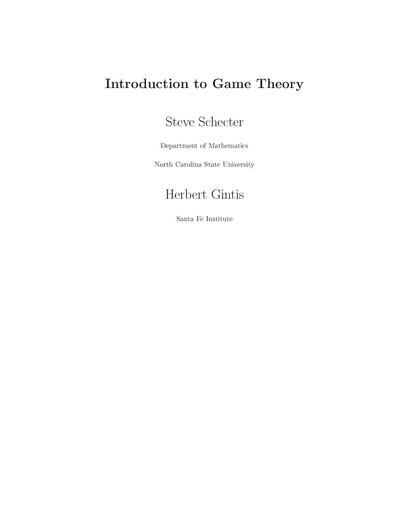
Introduction to Game Theory
This text grew from the material used to teach a game theory course in the North Carolina State University Mathematics Department. It combines material from the two books by Gintis with Schecter's notes, and adds some new material.
Tag(s): Game Theory
Publication date: 17 Jan 2012
ISBN-10: n/a
ISBN-13: n/a
Paperback: 237 pages
Views: 9,227
Type: Lecture Notes
Publisher: n/a
License: n/a
Post time: 28 Nov 2016 11:10:00
Introduction to Game Theory
 This text grew from the material used to teach a game theory course in the North Carolina State University Mathematics Department. It combines material from the two books by Gintis with Schecter's notes, and adds some new material.
This text grew from the material used to teach a game theory course in the North Carolina State University Mathematics Department. It combines material from the two books by Gintis with Schecter's notes, and adds some new material.
Publication date: 17 Jan 2012
ISBN-10: n/a
ISBN-13: n/a
Paperback: 237 pages
Views: 9,227
Document Type: Lecture Notes
Publisher: n/a
License: n/a
Post time: 28 Nov 2016 11:10:00
Traditionally, game theory has been viewed as a way to find rational answers to dilemmas. However, since the 1970s it has been applied to animal behavior, and animals presumably do not make rational analyses. A more reasonable view of animal behavior is that predominant strategies emerge over time as more successful ones replace less successful ones. This point of view on game theory is now called evolutionary game theory. Once one thinks of strategies as changing over time, the mathematical field of differential equations becomes relevant. Because students do not always have a very good background in differential equations, we have included an introduction to the area in Chapter 9.
This text grew out of Herb’s book [3], which is "a problem-centered introduction to modeling strategic interaction." Steve began using Herb’s book in fall 2005 to teach a game theory course in the North Carolina State University Mathematics Department. The course was aimed at upper division mathematics majors and other interested students with some mathematical background (calculus including some differential equations). Over the following years Steve produced a set of class notes to supplement [3], which was superseded in 2009 by [4]. This text combines material from the two books by Herb with Steve’s notes, and adds some new material.
Tweet
About The Author(s)
Herbert Gintis (Ph.D. in Economics, Harvard University, 1969) is External Professor, Santa Fe Institute, and Professor of Economics, Central European University. He and Professor Robert Boyd (Anthropology, UCLA) head a multidisciplinary research project that models such behaviors as empathy, reciprocity, insider/outsider behavior, vengefulness, and other observed human behaviors not well handled by the traditional model of the self-regarding agent.

Herbert Gintis (Ph.D. in Economics, Harvard University, 1969) is External Professor, Santa Fe Institute, and Professor of Economics, Central European University. He and Professor Robert Boyd (Anthropology, UCLA) head a multidisciplinary research project that models such behaviors as empathy, reciprocity, insider/outsider behavior, vengefulness, and other observed human behaviors not well handled by the traditional model of the self-regarding agent.
Professor in the Department of Mathematics at North Carolina State University. His research interests are traveling waves and their stability, and geometric singular perturbation theory.

Professor in the Department of Mathematics at North Carolina State University. His research interests are traveling waves and their stability, and geometric singular perturbation theory.